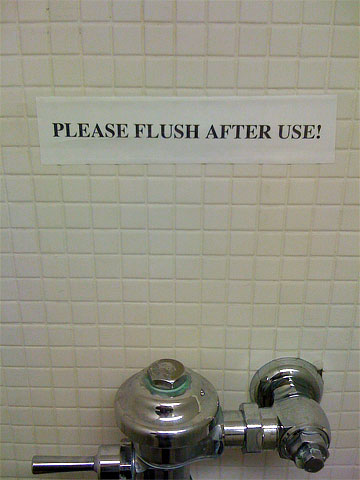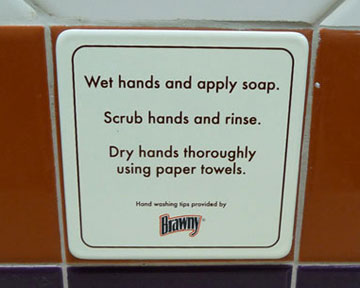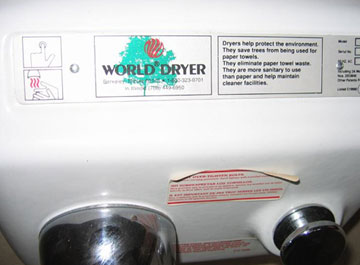Last week I visited one of the leading universities in the United States. It is especially famous for its outstanding research faculty. Academic brilliance flourishes in this place.
 I was meeting with a member of that faculty, and spent a few hours in his office. On his floor were a couple dozen colleagues in his field. When I went to use the men’s restroom, I was impressed by a sign that had been carefully taped above a toilet’s flushing mechanism. It read: PLEASE FLUSH AFTER USE!
I was meeting with a member of that faculty, and spent a few hours in his office. On his floor were a couple dozen colleagues in his field. When I went to use the men’s restroom, I was impressed by a sign that had been carefully taped above a toilet’s flushing mechanism. It read: PLEASE FLUSH AFTER USE!
Why, I asked myself, would highly educated people, leaders in their academic field, writers of recommended books, need this sort of sign? Didn’t their mommies teach them to flushing after use?
Perhaps the non-flushing professors were trying to save water by not flushing. Or, perhaps they’ve become so used to automatic flushers that they don’t remember to do it themselves. Or, perhaps this sign is proof that professors can be brilliant in one thing and rather dull in others. I was reminded of the time when I observed one of the most celebrated Harvard professors stuck in front of an ATM machine, unsure how to make it operate.
 The sign in the men’s room of the university reminded me of a similar sign I spotted last year while visiting Epcot Center in Disneyworld, Florida. I think I posted a photo of this sign on my website last year, but it’s worth another round. This most helpful sign was not a reminder to flush, but rather a set of instructions concerning what to do afterwards. It guided one through the steps of hand washing. I noticed that these “hand washing tips” were provided by Brawny, makers of paper towels. Thus I was not surprised to discover that the thrid step read: “Dry hands thoroughly using paper towels.” Notice, not just one paper towel, but paper towels, in the plural. I guess the Brawny people want you to use plenty of their product. Can’t figure out why . . . .
The sign in the men’s room of the university reminded me of a similar sign I spotted last year while visiting Epcot Center in Disneyworld, Florida. I think I posted a photo of this sign on my website last year, but it’s worth another round. This most helpful sign was not a reminder to flush, but rather a set of instructions concerning what to do afterwards. It guided one through the steps of hand washing. I noticed that these “hand washing tips” were provided by Brawny, makers of paper towels. Thus I was not surprised to discover that the thrid step read: “Dry hands thoroughly using paper towels.” Notice, not just one paper towel, but paper towels, in the plural. I guess the Brawny people want you to use plenty of their product. Can’t figure out why . . . . I guess nobody every told Epcot or Brawny about the downside of using paper towels to dry one’s hands after using the restroom. This downside can be found on electric dryers in public restrooms. Consider, for example, the sign that appears on the World Dryer: “Dryers help protect the environment. They save trees from being used for paper towels. They eliminate paper towel waste. They are more sanitary to use than paper and help maintain cleaner facilities.”
I guess nobody every told Epcot or Brawny about the downside of using paper towels to dry one’s hands after using the restroom. This downside can be found on electric dryers in public restrooms. Consider, for example, the sign that appears on the World Dryer: “Dryers help protect the environment. They save trees from being used for paper towels. They eliminate paper towel waste. They are more sanitary to use than paper and help maintain cleaner facilities.”There are studies that indicate that the use of hand dryers is, indeed, better for the environment, even though they use electricity. But, alas, this may not be the end of the story. In November 2008, scientists on the faculty of the University of Westminster, London, conducted a study comparing paper towels, warm air dryers, and jet air dryers in terms of efficiency and hygiene (download PDF of study). Here are some of their conclusions (italics added):
The results of all parts of this study suggest that paper towels should be used in locations where hygiene is paramount, such as hospitals, clinics, schools, nurseries, care homes, kitchens and other food preparation areas. Warm air dryers and jet air dryers should be carefully considered for these types of location because of their poorer hygiene performance and the increased likelihood of transmission of bacteria, including potentially pathogenic types, via the fingerpads and palms of the hand and their air flows. The performance of both the warm air dryer and the jet air dryer was inferior to paper towels in all respects (drying efficiency, bacterial numbers on the hands, bacterial contamination of the air flow and surfaces of the devices, and transmission of bacteria in the washroom) with the one exception that the jet air dryer is equal in drying efficiency.
So there you have it . . . or not. I wonder if the professors of the University of Westminster flush after use?

